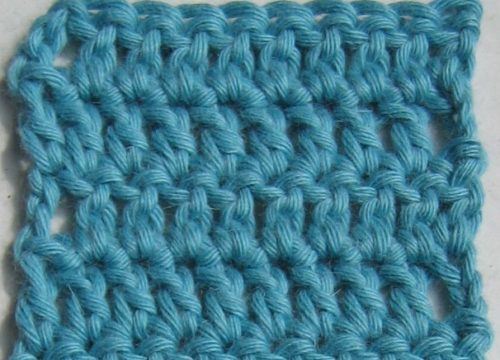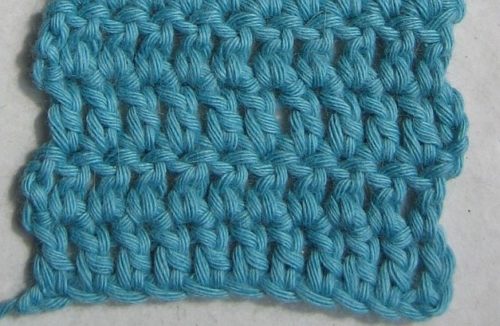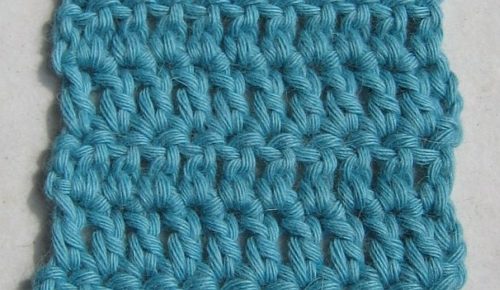The crochet turning chain
One of the first things you learn as a crocheter is to make a turning chain. At the beginning of a new row, your hook will need to « travel up » to the height of the next row. This is done by making a « ladder » of chain stitches, called the « turning chain ».
Most often, if you work in solid dc or a dc-based stitch pattern, the pattern (or the person teaching you how to crochet) will tell you to make a turning chain with 3 chain stitches. And most probably, you will be asked to count these 3 chain stitches as your first dc in the row.
This means that you will skip the first stitch, and make your first « real » dc in the second stitch of the row. The result looks something like this:
See that little gap in the beginning of every row? It occurs because the turning chain acting as the first dc starts at the very edge of the fabric, and not in the stitch on the previous row. It doesn’t help that the chain stitch is typically thinner than a fully formed double crochet. If you have crocheted for some time, you have perhaps decided to live with the little gap, accepting it as one of the crochet technique’s personality traits. Why not?
But perhaps you are like me, and that little gap bugs you, especially when you make things made in several pieces that need to be sewn together.
The first step in my quest for the gapless seam was to ignore the common advice and not count the turning chain as the first stitch in the row. In this case, you will chain 3 sts and make the first dc in the first stitch of the row:
This way, every stitch in the row is a « real » stitch. The gap is eliminated.This method also makes life much easier for the beginner – and even for the more experienced crocheter. It is much easier to count stitches in a row, since every stitch is a real stitch, forming a neat « V » or chain on the top.
This also means that the risk of unwanted decreases is reduced – it’s easier to spot the place where the last stitch of a row should be worked when it is a stitch like the others, and not a meager turning chain.
However, I was not entirely happy with this solution. I found the edges too uneven. The turning chains made of 3 chains were too visible. So I turned to the method I’m using currently – a 2-ch turning chain, which doesn’t count as a stitch:
This turning chain is much closer to the actual height of the double crochet. The edge is neater, and the slight unevenness caused by the turning chains is easily hidden in a seam or edging.
When working this shorter turning chain, you will notice that the first stitch of the row seems to be pulled down a little. Don’t worry – this will even out when the next row is worked. However, if even after several rows you feel that the edges are too tight, it is better to try adding an extra chain to the turning chain.
There is another method. I don’t currently use it, but it’s worth mentioning. Instead of working a turning chain, you can simply pull up the loop on your hook to the height of your next row and immediately work your first stitch. This will require some testing in the beginning, and you will need to control your loop size very carefully. But who knows, it might become your own method of choice!
See you soon!






I am glad I found this post from years ago. I am copying a simple scarf from my Oma from 44 years ago all in double crochet. Her edges were so straight. I stepped through this post, tried things and compared the edges/loops. I found the last method was perfect and what my Oma used. Making the final loop at the end of the row longer and no turning chains, results in very straight edges. Thank you for this post.
I’m so glad it was helpful, Kristina!